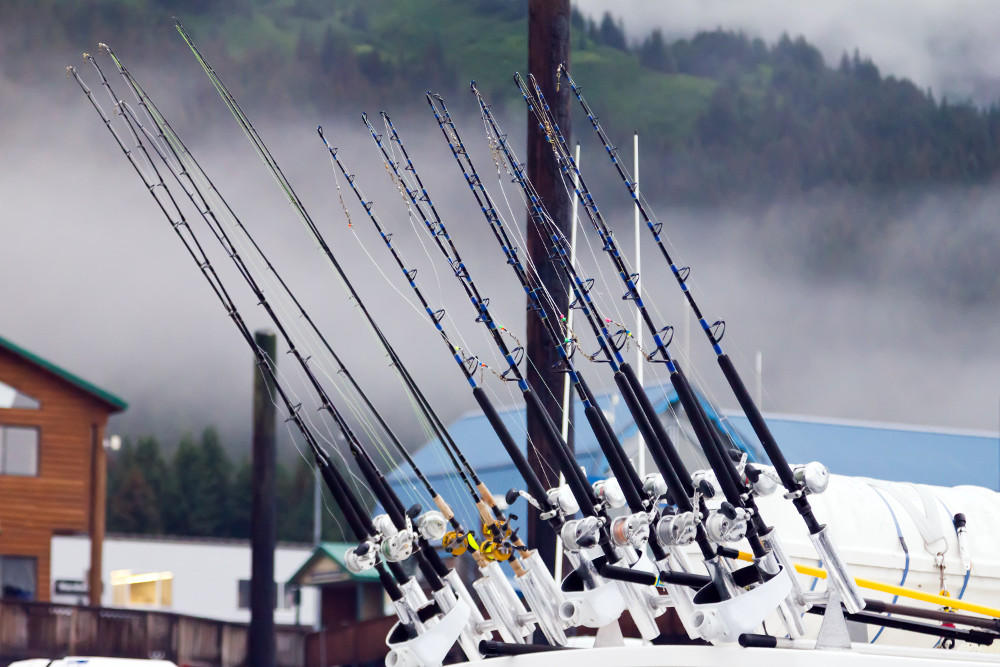Different Types of Fishing Rods

Fishing is one of those sports where you can have great success keeping things simple, but there’s also an incredible amount of gear available for you to help increase your chances of success, as well as optimize your style of fishing to make it as fun for you as possible.
A fishing rod is obviously an essential piece of equipment to have when going fishing, but if you don’t have your own fishing rod and haven’t bought one before, the vast selection can make it overwhelming to try and come to a decision. Therefore, in this article, we will attempt to clarify the different types of fishing rods, what makes them different, and the main things you will want to look for when buying a new fishing rod.
Different Types of Fishing Rods
Fishing rods can be categorized based on many different features, but let’s start with the most general. If you know what type of fishing you will be doing, or what type of reel you prefer, you’re already well on your way to narrowing your selection. Here are the different general types of fishing rods you can find at your local tackle shop.
- Spinning Rod
Spinning rods are some of the best all-around fishing rods. These types of fishing rods are commonly used for smaller fish like panfish but are also more than capable of battling moderate sized fish such as bass and walleye. These rods are usually made out of graphite or fiberglass, with the ideal material depending largely on the type of fishing. For more info about when to use a graphite rod or a fiberglass rod, please check out the video below courtesy of Fox Sports Outdoors.
These rods are combined with a spinning reel which is mounted below the rod at the handle. With this arrangement, the angler can grip the handle at the point of the reel for optimal balance, leverage, and comfort. Handles are typically made of cork or EVA foam, each of which is ideal for casting.
Spinning rods will have multiple line guides running along the length of the rod. The line will come off the spool of the reel and subsequently run through the line guides which gradually descend in size, ultimately helping to manage the alignment and tension of the line. For the best performance and durability, ceramic guides are recommended, but inexperienced anglers are unlikely to notice a difference. Longer and more flexible spinning rods will have more guides than shorter or stiffer rods.
- Spincasting and Baitcasting Rods
Spin casting rods and baitcasting rods are essentially the same, as the main difference lies in what type of reel you select, and therefore are commonly termed “casting rods”. Casting rods are different from spinning rods in the reel is placed above the handle on top of the rod. This works for both spin casting reels and baitcasting reels, where spin-casting reels are better for beginners and baitcasting reels are ideal for experienced anglers.
This type of fishing rod will also have a forefinger grip that resembles a trigger. This is necessary to provide comfort and ideal function for the reel, as the line is usually released by pressing a button on the reel with your thumb. Having the forefinger grip under the rod will allow you to maintain control of the entire system in a comfortable manner.
Casting reels function differently than spinning reels, and one of the most noticeable differences is the much smaller pool that is set up in a different orientation. Compared to a spinning reel, the line from a casting reel will come off the reel much more straight, so it doesn’t need as much help from the guides, to begin with.
Casting rods, in particular, baitcasting rods, are often selected by anglers who are fishing for larger fish that put up a bigger fight. These rods are better suited for the heavier line, and these factors combined also make them a better option when fishing in heavy cover. That being said, spinning rod and reel combos can definitely be used for larger fish as well. At the end of the day, it simply comes down to personal preference.
- Trolling Rod
Trolling is a type of fishing whereby the line/bait is dragged through the water behind a boat. Technically, trolling can also include other forms of retrieval, but for the purpose of this article, we will be considering the classic form of trolling from a boat. In trolling you need proper trolling accessories like trolling motor, battery, and other accessories where you can check at trollingbatteryguides.com.
Theoretically, you can use any fishing rod for trolling, but often times your standard spinning and casting rods will not be sufficient for hauling in any fish that strike your line with force, especially in saltwater environments. Conveniently, many fishing rod brands now have product lines dedicated to trolling rods, so they can be quite easy to identify when looking for a new rod.
Generally speaking, most trolling rods fall within the range of 7-9 feet, which is a good all-around length that many anglers will be familiar with. They are usually medium-fast action rods that provide a balance between being able to withstand the striking force and fight of the fish without tearing the hook out completely. Many anglers find slow action rods are extremely difficult to use once they set the hook, so these are typically avoided.
Trolling also places a little more stress on the rod and line than usual, so some trolling rods have different types of guides to help minimize wear and tear. For example, roller guides have become increasingly popular on trolling rods, especially when fishing much larger fish, as this will reduce the amount of friction on the line once a fish has been hooked.
- Fly Fishing Rod
Fly fishing rods are quite a bit different from spinning rods and casting rods mainly due to the casting technique involved. Fly rods tend to be a more flexible type of fishing rod, as a back-and-forth sweeping motion is used during the cast in order to draw the outline and place the artificial fly at the desired location. Overall, fly rods tend to be slightly longer than their spinning and casting counterparts, but they do come in a large range of sizes. Shorter rods are better for more confined spaces, lighter line and flies, and shorter casts. The opposite holds true for longer fly rods.
Fly fishing rods are most commonly made of graphite, but you can also find fiberglass fly rods, as well as fly rods that have advanced components in the manufactured material such as nano-silica resin. For those looking for a taste of history, bamboo has also been used throughout the past for fly fishing applications.
Fly fishing rods are generally categorized according to rod weight, where the weight will have a value of 0-10+. If you plan on fishing for smaller and lighter fish, then you will require a smaller rod weight, and conversely, a larger rod weight will be better for larger fish. For example, a rod weight of 0-4 would be ideal for panfish, 4-6 for average sized trout, 5-9 for bass, 8-12 for northern pike and musky, 10-14 for mahi-mahi, and 14 for marlin. Fly rod weights should be matched with the same line weight, and fly reels are also categorized in this manner, which makes it easy to match everything up appropriately.
For any given fly rod weight, you can also have different types of flex and action. The terms flex and action are often used interchangeably, but they are fundamentally different. Flex refers to the physical deformation of the rod, that is, how much it bends during the cast. Action refers to how quickly the rod will acquire or release the load placed on it. Slow action rods with lots of flex are a nice choice for beginners, as you can get a better feel for the casting technique. This setup will also facilitate shorter casts and lighter presentations, whereby the loop on the forward cast will be much larger allowing you to “place” the fly on the water much more delicately. However, the larger loop during the cast can be a problem in high winds. Stiffer and faster action rods will allow for greater casting distances, require a little less physical effort more the angler, and can allow the line and fly to cut through the wind easier.
- Ice Fishing Rod
An ice fishing rod is a type of fishing rod that can be easily distinguished by its size. The Ice fishing rods are typically way smaller than normal fishing rods, but many of the same principles regarding design and function still apply. Most anglers have them set up with spinning reels, which makes it easier to simply drop the line through the hole in the ice, but small fly reels are becoming increasingly popular as well.
Fly rods are usually made of graphite or fiberglass. Graphite is more lightweight, more sensitive, and better for jigging, but it’s also more expensive than fiberglass. Given that ice fishing rod themselves are pretty short, it can be easy to ignore the quality of the guides, but this is actually a practical consideration that many anglers find very important. More guides will lead to a straighter release and a more balanced setup, and larger guides are preferred by many anglers due to the build-up of ice over time. If ice builds up on the guides, this can prevent the travel of the line and also cause abrasion, so larger guides can be ideal to avoid this issue, or at least see the progression a little easier.
While ice rods are shorter, on the whole, they still can vary in size. Shorter rods are better for smaller spaces and will also be more sensitive, allowing you to feel the bites much easier. However, longer rods will make the fight a little easier after the fish strikes, so there’s a little bit of a trade-off in either direction. At the end of the day, it simply comes down to personal preferences, where ours is leaning towards a shorter rod.
Summary
We hope you enjoyed this guide to the different types of fishing rods, and that you now have a better idea of what to look for when shopping around. Stay tuned for more information on the different types of fishing rods, as we will be providing more detailed info for each type of fishing rod in articles that will be released shortly. Please check back soon!
